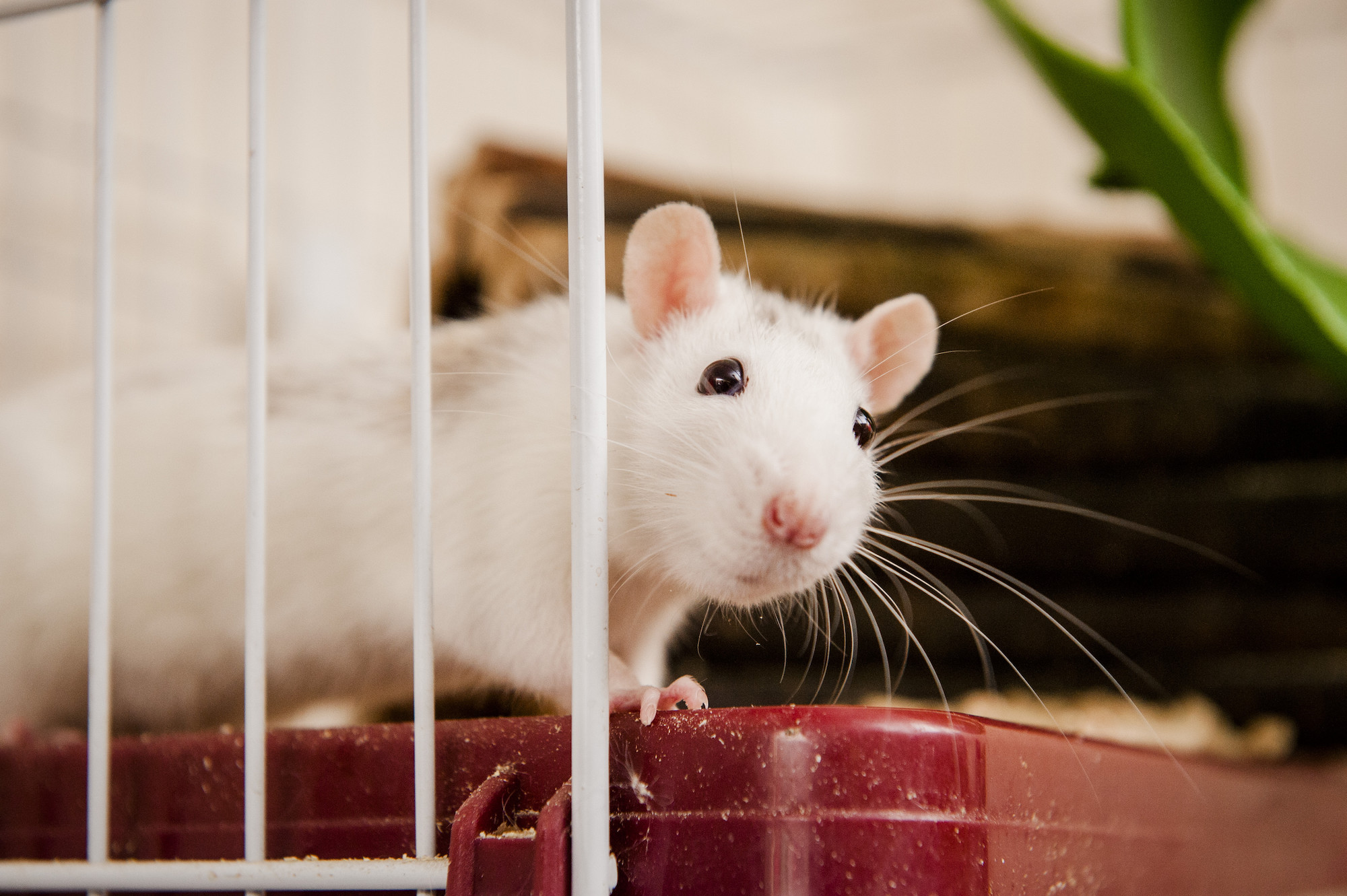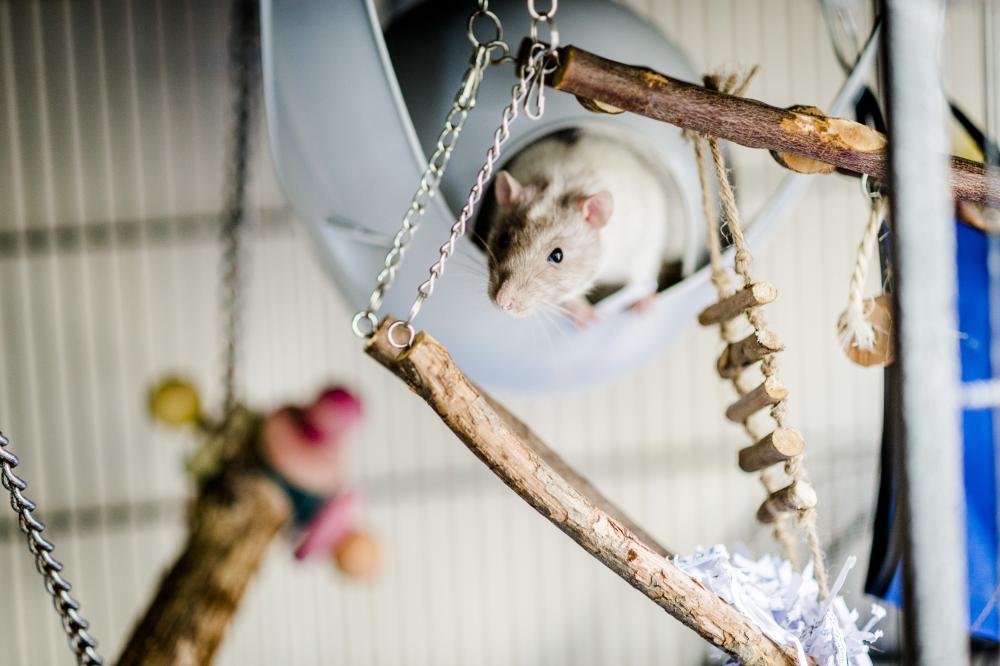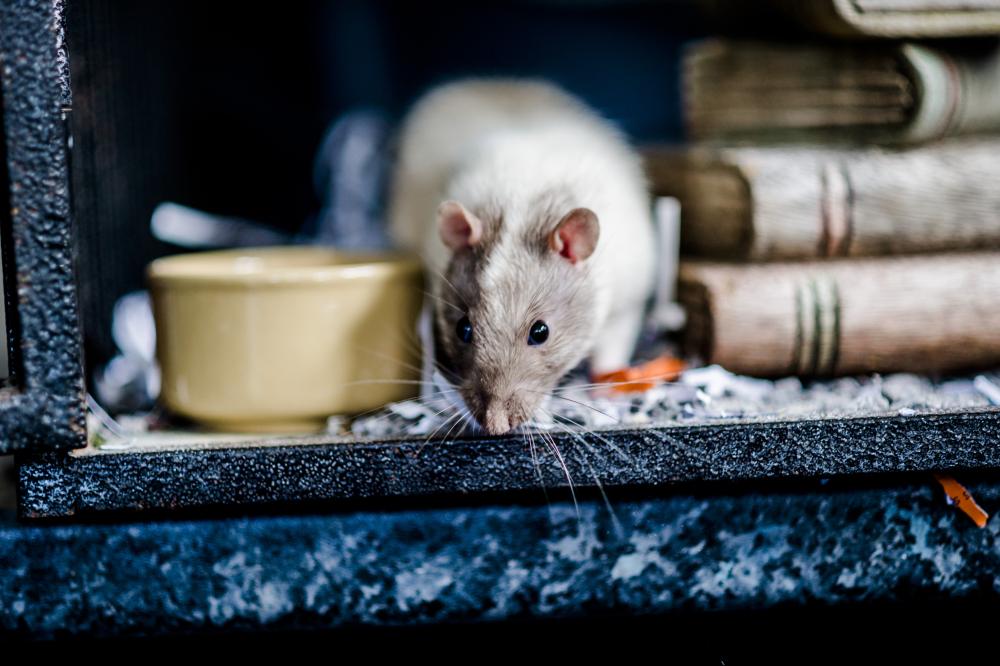
Caring for your pet rat
There are lots of varieties of rat with different coats and eye colours. These include white, cinnamon, blue and parti-coloured coats with dark or pink eyes.
Male rats are called bucks and females are does. Baby rats are known as kittens.
Are rats the right pet for you?
Pet rats are clean, intelligent, enjoy human company and make great pets for families. But they do need lots of attention, so you'll need lots of time to care for them. They'll need daily social interaction and at least an hour of exercise outside their cage every day, so it's important that everyone in the family is keen on the idea of keeping rats as pets.
Are rats a good pet for children?
Rats are easier to handle than smaller rodents, like hamsters, as they're bigger and many will enjoy the attention! If you're thinking about getting rats for a child, they can make a more suitable pet. But, as always, an adult must be responsible for making sure the rats receive the attention and care they need. Children will also need to be supervised while holding them.
How long do pet rats live?
On average, rats live for around two and a half years.
Do rats need company?
Rats need company of their own kind; it’s unfair to keep one alone because they're social animals. Single rats can even become depressed.
To avoid unwanted babies, the best option is usually a pair or group of the same sex. If your pair or group is mixed, make sure the male is neutered to prevent unwanted litters.
Tip
Male rats tend to get on very well if they have grown up together. If they start fighting and fall out, talk to your vet about neutering as this may help.
When do rats sleep?
Rats are nocturnal, which means they're most active at night and at dawn or dusk.
Because of their sleeping pattern, you may need to think about where to keep them. They're very social and will like to be somewhere they can see you, but you may not want them to keep you awake at night!
Where to get rats
Animal charities
Rescue centres like ours will have rats that need good homes. We generally rehome rats in pairs or groups, but we also have single rats looking for company – it's never too late to get your rat another friend.
Breeders and pet shops
Here are some things to bear in mind when considering buying from a pet shop or breeder:
- Be wary of buying a rat from somewhere with lots of other rats, particularly if any of them have rapid or noisy breathing as this can be a sign of a contagious respiratory infection
- If you’re looking for babies, they should be at least six weeks old before you bring them home
- They should be health checked by a vet and accurately sexed before taking them home
- They'll also need to be separated from the opposite sex by five weeks old
- If you buy from a pet shop, make sure the animals have been kept in same sex groups and that the staff can show you the difference between males and females
- It's also really important that they are living in a cage that's big enough
How much are pet rats?
If you rehome from us, you will pay a fee per rat. This fee includes the cost of:
- having them looked over by a vet if needed
- being assessed by an experienced member of our team
We appreciate we may not always have rats available for rehoming. So, if you choose to go to a breeder or pet shop, you will pay, on average, anywhere between £15 to £25.
Caring for your rats
What do I need to buy for my rats?
Rats need:
- a suitable wire cage
- the right bedding
- food
- earthenware or stainless steel bowls for food
- water bottle
- a nest box
- playtime outside of their cage
- toys to keep them entertained
- a carry case for trips to the vet
As well as the above, your rats need a constant supply of water. You may also want to consider getting pet insurance.
Rat cages
The best home for your rats is a wire cage – the larger and taller the better, as rats are active and love to climb.
A rat cage should be at least 90cm (L) x 60cm (D) x 120cm (H) for two to five rats (larger for bigger groups). This is just the actual living space and these measurements should not include stands.
The floor should also be solid rather than wire to avoid them trapping and injuring their feet or limbs. Aquarium-style glass cages should not be used because there will not be enough ventilation.
Note
Hamster cages are not big enough for rats.
Where to keep your rat
Rats can be quite sensitive to noises and the environment they live in. To help them stay happy and healthy, they'll need to be:
- indoors – it's too cold for pet rats outside
- away from any draughts and direct sunlight – rats are sensitive to extreme cold and heat dehydration, both of which can be fatal
- somewhere they can see and hear you – they're very social and like to keep an eye on their owners
- away from loud noises and vibrations given off by televisions and speakers, as this can be stressful for them
Bedding
Bedding which is safe for your rat includes:
- a dust extracted bedding, such as paper-based bedding
- non-aspen wood chips
- cellulose-based chips
Bedding to avoid
Avoid wood shavings or sawdust as this can cause respiratory problems.
Fluffy or stuffing type bedding can also be dangerous. It can get wrapped around their feet or limbs and cause an injury – it also doesn’t dissolve if eaten.
And, because rats are so sensitive to smell, you should not use bedding with an added fragrance.
Shelter
Rats also need a nest box where they can sleep and enjoy a bit of peace and quiet. A cardboard box with shredded paper bedding is perfect.
Litter training your rats
Rats can be litter trained, but ensure the litter you're using is safe for rats and different to the material used in the rest of the cage to help the rats make a distinction between the two areas.
Once you know their favourite place to go to the toilet, place some different rat-friendly bedding there. They'll then get used to going in that place, and where that particular type of bedding is. This will make it easier for you to spot clean their cage.
How often do I need to clean my rat's cage?
You should check their cage every few days and remove any dirty bedding. This is important as a dirty cage can cause breathing problems and lung infections in rats.
You'll also need to clean the cage out completely using a pet-friendly cleaner once a week. But there are some important things to remember:
- Cleaning their cage will remove their scent, so keep some of their bedding back so you can place it back into the cage – this will reduce their stress
- Keep their cage in the same place
- Avoid loud noise, such as music, during the process – rats don't like it!
How to clean a rat's cage
- Wait until your rats are awake
- Remove your rats from their cage for their daily exercise or place them in a pet carrier
- Take out any ropes, hammocks or toys, cleaning them as needed
- Scoop out their bedding and any other material using a dustpan and brush
- Using a pet-safe disinfectant, which you can buy in a pet shop, spray the cage
- Then wipe it all down and wash thoroughly with warm water
- Leave to air for around 30 minutes until completely dry
- Clean their food bowls and their water bottle, using warm water and a bottle brush
You're now ready to set it back up.
- Add in new bedding
- Place their toys in – you can vary their toys or move them around to keep things interesting!
- Add fresh water and food
Enrichment
Rats are very active and social. They love playing and will need lots of objects and activities to keep them entertained.
Enrichment outside their cage
Rats need at least an hour of playtime outside their cage every day, but you must first make the room safe and rat-proof.
- Keep doors and windows closed and block cracks in floorboards, as rats can get through very small gaps
- Keep house plants out of the way because some are poisonous to rats
- Electric cables should be covered by protective piping so they cannot be chewed
Making enrichment for your pet rats is easy as you can use almost any household object and adapt them, such as cardboard boxes, PVC pipes, plant pots, fruit treat branches and rope.
Enrichment inside their cage
You'll also need to provide them with entertainment in their cage. Here's some ideas:
- A cage with multiple levels as they love climbing
- Hang up rope toys
- Buy a rat-friendly hammock – you can make one easily by tying or clipping a small towel to the top of the cage
- A rat-friendly exercise wheel
- Cardboard tubes and boxes to hide in and chew on
- Rat-friendly pet toys – these should be available from good pet shops but you can also use tree branches, old toilet paper tubes and plant pots
- Hide trails of food around for them to find
- A gnawing block to keep their teeth healthy
Get more ideas for keeping your rats entertained.
What do pet rats eat?
Rats love a varied diet that includes grains, vegetables and a protein source, such as dry dog food. Commercial mixes are available from pet shops.
While rats are fond of titbits and household scraps, be careful not to let them overeat and become overweight. They will enjoy occasional pieces of fruit and vegetables, but peanuts and sunflower seeds should be a rare treat as they are high in fat.
Fresh, clean water must always be available. If a water bottle is used it should be cleaned, refilled and checked daily to ensure it's not blocked or leaking.
How much should I feed my pet rats?
Rats can quickly become overweight and this may cause health problems. It's important to make sure that:
- you're not giving your pets too many treats
- you give them the correct amount of food
- they have lots of enrichment opportunities to keep them active
If they do become overweight, speak to your vet for more advice.
How to feed my pet rats
Put food in earthenware bowls (which are hard to tip over), or stainless-steel bowls that clip on to the cage. You can also hide their food so they have to find it.
How to keep pet rats healthy
You'll need to check daily for general signs that they're unwell. These might include:
- loss of appetite
- lethargy or tiredness
- putting on or losing weight
- runny nose or eyes
- red discharge around the nose or eyes
- wheezing or sneezing
If you are worried about any change in your rat’s health, consult your vet. Your rat will also benefit from an annual health check from the vet.
Respiratory diseases
One of the most common problems in rats is infectious respiratory disease. Common symptoms include:
- laboured or wheezy breathing
- sneezing frequently
- breathing with their mouth open
Some rats might not show any symptoms but will still carry the disease, meaning they can pass it on to other rats. But, it can only be passed from one rat to another – it cannot affect other species or humans.
If you notice any of the symptoms, speak to your vet as soon as possible so that your rat can get treatment. Sometimes it isn't always curable and will come and go.
Red discharge
Rats produce red discharge around the eyes or nose if they're ill, in pain or stressed. This is a natural pigment in the mucus – it's not blood. But, you should still speak to your vet.
Cancer in rats
Rats can develop tumours as they get older – these are more common in females. Some cancers will be more serious than others, but you should still talk to your vet if you find a lump or bump. They will be able to tell you whether it should be removed surgically.
Grooming
Rats are naturally very clean and spend a lot of time grooming themselves.
Some rats may need their tails cleaned occasionally. This should be done gently with mild animal shampoo or by wiping using unscented baby wipes.
Will my rats want to breed?
Rats will frequently breed from as early as five weeks old, producing a litter of eight or more young each time. Females can become pregnant again within 24 hours of giving birth, so it's important not to keep a male and female together unless they're neutered.
Neutering your rat
We usually recommend keeping rats in same sex pairs or groups. But, if you do have a mixed pair or group of rats, you'll need to have any males neutered to avoid them breeding with any females.
Unneutered males can also fight, so neutering often helps reduce aggressive behaviour and fighting. Speak to your vet for more information about neutering.
Is my rat playing or fighting?
Rats often play together and this might look like fighting. But, to make sure it's harmless fun, watch out for any of these signs:
- Injuries to one or both of your rats
- One of your rats hiding from the other
- Bites to either or both rats
- Being vocal during a fight
- Their fur standing on end during a fight
- Over-grooming – this can be due to stress
Introducing rats
Introducing cage mates soon after weaning (at around three weeks of age) or keeping siblings of the same sex together will reduce fighting.
You should also avoid adding or removing rats from a group if you can, as this can lead to aggression. Rats form strong social groups and get used to their cage-mates, so changes can be stressful and unsettle them, leading to fights.
But there might be some situations where you have to introduce rats, such as if their cage mate dies. If you need to introduce rats for the first time, they can become aggressive. This should settle down once they get used to each other. If they're unable to get along, they may not be able to live together.
What to do if your rats are fighting
Here are some tips that might help with aggression in rats.
- Give them enough food, water and hiding places so they do not have to share resources (eg separate food bowls)
- Make sure their cage has multiple levels and that shelters have multiple exits, so that they do not have to be around each other all the time
- Think about separating your rats if one of them is injured or the fighting continues for more than a few days
Important
Unusual fighting in a settled group of rats might indicate a health problem or that your rat is in pain. Speak to your vet for advice.
Handling your rats
You should spend at least an hour a day handling your rats if they enjoy it and letting them exercise outside their cage, so it's important to know how to pick them up.
If they're handled correctly from a young age, they'll develop a strong bond with you and enjoy being picked up. To help them get used to you, try carrying them around the house inside your jumper!
How to handle your rats:
- Put one of your hands underneath their chest behind their forelegs
- Hold tightly enough to be secure without squeezing
- Put your other hand underneath their back legs for support
Important
Never pick up a rat by its tail as this can injure them.
Supervising children:
Once rats are used to being handled by an adult, children should also be able to pick them up. But, it's important that they are supervised to make sure they do not hold the rats too tightly.

Donate today
We rely on donations to provide accurate, expert pet advice. If you found this page useful, help us by donating.

Donate today
We rely on donations to provide accurate, expert pet advice. If you found this page useful, help us by donating.






